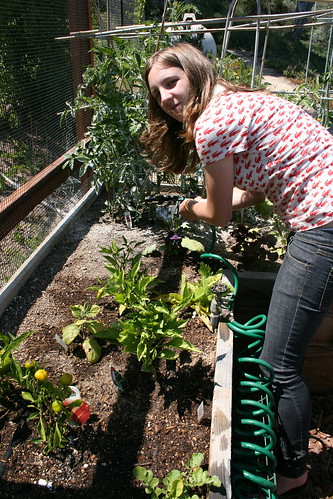Showing posts with label gardening. Show all posts
Showing posts with label gardening. Show all posts
Saturday, September 19, 2009
Lulu's User-Friendly Guide to Pruning Banana Clumps
As a WWOOFer at Hale Akua Garden Farm, I take care of all sorts of plants: taro, Hawaiian ginger, tumeric, bok choy, carrots, beets, okra, etc. One of my more exciting responsibilities is caring for our 30+ banana plants using a very serious machete.
Thus, I give you an overview of what this task entails...
1. Pull all the weeds and extraneous grass away from the base of the clump. This will give you a clean workspace and room to consider the dense structure of the plant at hand. My boss is very exacting, so I’ve gotten used to doing a lot of weeding. Mostly, in this case it just looks nice.
2. Bananas like to keep a close-knit O’hana (Hawaiian for "family"): a daddy, a mommy, a teenager, and a baby (or one mature mommy and one less mature mommy – however PC you’d like to make this scenario, be my guest). Either way, kill the rest of the family with a giant machete. The stalks that are preparing to bear fruit get to stay. In addition to those, keep one slightly smaller one and also one young shoot. Cutting back family members will help ensure that the surviving ones have enough nutrients to bare fruit.
3. Use the bodies from the offed family members to fertilize the remaining family members: cut trunks into thirds and place around the base of the plant. Put the large leaves around as well, and tuck into the free space in between stalks.
4. Be careful not to hit your head on the enormous banana flower as you are moving around the clump.
5. Harvest the bananas (the actual fruits) the moment they begin to turn from green to yellow.
And check out this delicious baked treat from Gourmet that we prepared using our harvested bananas.
Wednesday, July 02, 2008
Let Us Discuss Lettuce

This summer I am taking a directed study course on arts reporting with assignments from Professor Teresa Moore and the Professor of Pop, Andrew Goodwin.
One of my first assignments was a food comparison exercise. I was to select and compare nine different types of salad greens, focusing on aspects like softness/crunchiness and sweetness/bitterness, among others. Here is what I found:
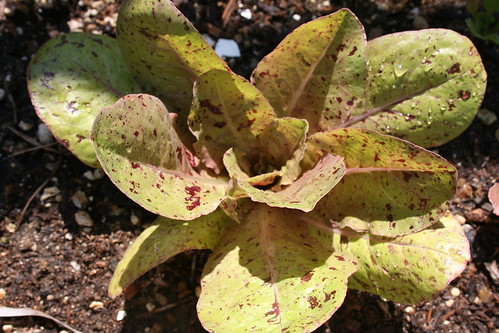 Freckles romaine lettuce -- an heirloom variety -- is oval, narrowing at the base of the stem. The leaves are smooth, slightly waxy and very thin, tearing easily. Their color is striking – pale green with blood-red freckles and a light pink stem. They taste grassy and nutty with a sweet finish.
Freckles romaine lettuce -- an heirloom variety -- is oval, narrowing at the base of the stem. The leaves are smooth, slightly waxy and very thin, tearing easily. Their color is striking – pale green with blood-red freckles and a light pink stem. They taste grassy and nutty with a sweet finish. Frissée
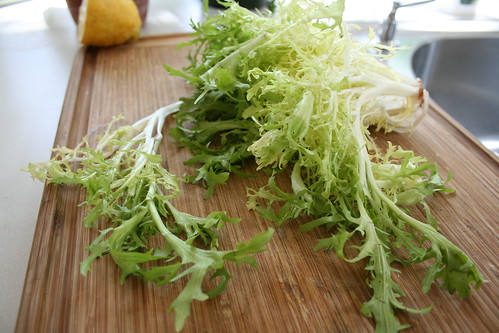 Frissée has thin pale-yellow branch-like stems off a thicker main stem. The jagged, narrow chartreuse green leaves on these branches curl around each other, adding to the tangle of aggressively bitter greens. The leaves are soft, but the stem is crunchy and rigid – this unusual structure makes it somewhat difficult to eat.
Frissée has thin pale-yellow branch-like stems off a thicker main stem. The jagged, narrow chartreuse green leaves on these branches curl around each other, adding to the tangle of aggressively bitter greens. The leaves are soft, but the stem is crunchy and rigid – this unusual structure makes it somewhat difficult to eat.Iceberg
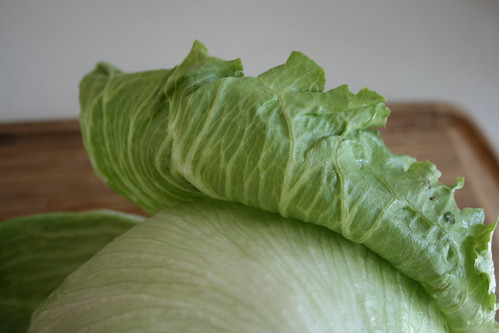 Iceberg lettuce has waxy, concave round leaves with a ragged edge. These leaves hug closely to one another, the foremost leaves conforming to the layers beneath it. Iceberg is pale green at the base and lime green around the edges of the leaves. The top of each leaf is soft and floppy and partially crunchy like Styrofoam towards the base. It is watery and sweet with a grassy finish.
Iceberg lettuce has waxy, concave round leaves with a ragged edge. These leaves hug closely to one another, the foremost leaves conforming to the layers beneath it. Iceberg is pale green at the base and lime green around the edges of the leaves. The top of each leaf is soft and floppy and partially crunchy like Styrofoam towards the base. It is watery and sweet with a grassy finish.Spinach
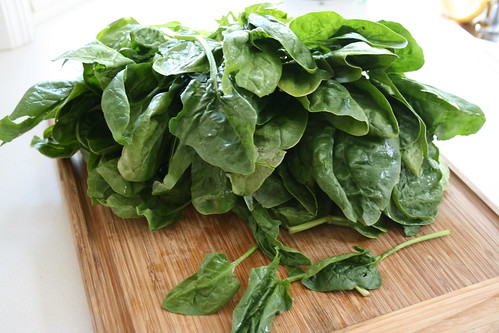 Spinach’s fibrous, dimpled leaves are lobed, almost spade-shaped at times and grow a single leaf to each stem. They are medium green, dull and soft with fine veins. The stems are long, thin and crunchy. Spinach is nutty and slightly salty with a metallic finish. The stem has a greater concentration of this flavor. The smaller leaves seem to be bitterer.
Spinach’s fibrous, dimpled leaves are lobed, almost spade-shaped at times and grow a single leaf to each stem. They are medium green, dull and soft with fine veins. The stems are long, thin and crunchy. Spinach is nutty and slightly salty with a metallic finish. The stem has a greater concentration of this flavor. The smaller leaves seem to be bitterer.Romaine Lettuce
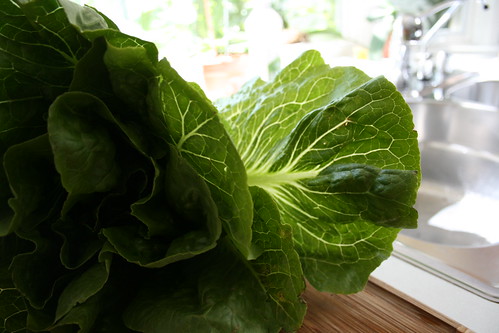 Romaine is large, compared to other salad greens, with a round tip that becomes jagged on the edges near the base. It is leathery and slightly ruffled with many veins and a big stalk-like pale green stem. The leaves are a medium green with a mild flavor and only a hint of bitterness in the stalk. The leaves are soft relative to the crunchy stem.
Romaine is large, compared to other salad greens, with a round tip that becomes jagged on the edges near the base. It is leathery and slightly ruffled with many veins and a big stalk-like pale green stem. The leaves are a medium green with a mild flavor and only a hint of bitterness in the stalk. The leaves are soft relative to the crunchy stem.Radicchio
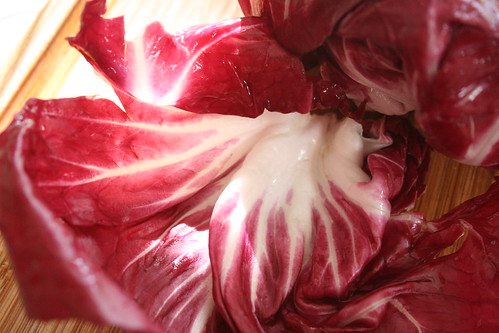 Radicchio is soft and flexible at the edge of the leaf with a stiff, crunchy stem. It has a waxy texture, similar to iceberg lettuce – rounded into a concave “bowl” with many ripples and folds. Radicchio is predominantly a saturated magenta with contrasting white veins and stem. Its taste is equally sweet and bitter.
Radicchio is soft and flexible at the edge of the leaf with a stiff, crunchy stem. It has a waxy texture, similar to iceberg lettuce – rounded into a concave “bowl” with many ripples and folds. Radicchio is predominantly a saturated magenta with contrasting white veins and stem. Its taste is equally sweet and bitter.Arugula (from my garden)
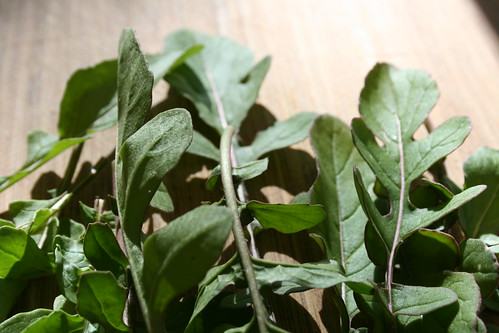 Arugula has a thin, crunchy stem and soft, flat lobed leaves that increase in size up the stem and end with a round lobe at the top. These leaves are grass green with thin magenta veins and rimmed with the same bright pink color along the edge. Arugula is not overly toothsome, but it is fibrous like spinach. The taste of arugula is nutty and salty initially, followed immediately by intense bitterness and a peppery punch that moves in quickly and recedes slowly from the tongue. The flowers are also edible with a similar taste.
Arugula has a thin, crunchy stem and soft, flat lobed leaves that increase in size up the stem and end with a round lobe at the top. These leaves are grass green with thin magenta veins and rimmed with the same bright pink color along the edge. Arugula is not overly toothsome, but it is fibrous like spinach. The taste of arugula is nutty and salty initially, followed immediately by intense bitterness and a peppery punch that moves in quickly and recedes slowly from the tongue. The flowers are also edible with a similar taste.Red Mustard Greens
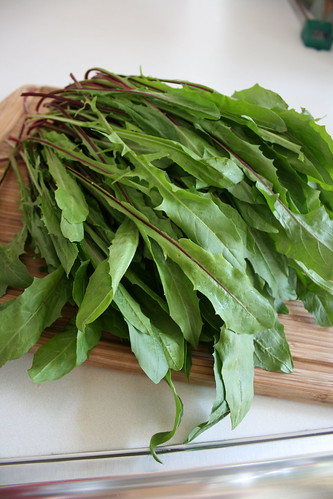 Mustard Greens are thin and feathery, like a quill, with a pointy leaf and edges that poke out like flattened green fused thorns. The leaves are flat towards the tip and slightly curly where jagged along the edge. The stem is crunchy with tiny prickly hairs that disappear towards the base of the leaf. Most leaves are a medium green with a yellow tone; however, some have a deep pink stem, much like radicchio, while some stems are predominantly yellow with a hint of pink. The flavor of mustard greens is intensely bitter (the magenta-stemmed ones appear to be more bitter than their yellow-stemmed counterparts), then nutty with an acrid finish.
Mustard Greens are thin and feathery, like a quill, with a pointy leaf and edges that poke out like flattened green fused thorns. The leaves are flat towards the tip and slightly curly where jagged along the edge. The stem is crunchy with tiny prickly hairs that disappear towards the base of the leaf. Most leaves are a medium green with a yellow tone; however, some have a deep pink stem, much like radicchio, while some stems are predominantly yellow with a hint of pink. The flavor of mustard greens is intensely bitter (the magenta-stemmed ones appear to be more bitter than their yellow-stemmed counterparts), then nutty with an acrid finish.Belgian endive
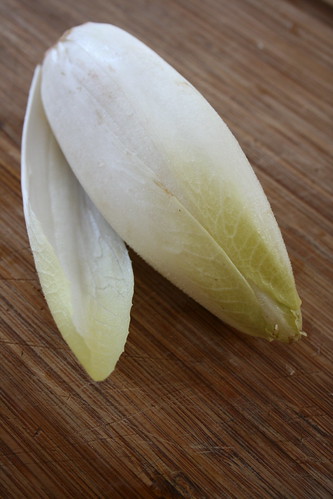 Belgian Endive’s leaves are very pale – almost white – yellow with light fuzz (like one finds on a peach). This fuzz is denser on the top of each leaf. The edge of the leaf is soft and tears easily. The stem is thick and crunchy and blends into the thin leafy portion. The leaves fit tightly together like shingles to form a dense core and when pulled apart resemble hollowed out rabbits’ feet. Belgian endive is slightly bitter, although less so than frissée.
Belgian Endive’s leaves are very pale – almost white – yellow with light fuzz (like one finds on a peach). This fuzz is denser on the top of each leaf. The edge of the leaf is soft and tears easily. The stem is thick and crunchy and blends into the thin leafy portion. The leaves fit tightly together like shingles to form a dense core and when pulled apart resemble hollowed out rabbits’ feet. Belgian endive is slightly bitter, although less so than frissée.These are just a few of the many varieties of lettuce out there. Next on my agenda is to make three recipes using some of these greens. Stay tuned for that.
Tuesday, June 24, 2008
June in Review
Ok, so a quick game of catch up on my whereabouts:

I have been busy here in San Diego doing a little gardening with Sky...
Taking care of a friend...
Interviewing local bands...
and learning about Life in the Ocean at the University of San Diego.

Next on my agenda is some work on a local cookbook and my arts reporting directed study, taught from afar by Professor Moore, advisor to the San Francisco Foghorn.
Labels:
gardening,
life in the ocean,
Lucy,
Rancho Santa Fe,
San Diego,
summer,
The Silent Comedy,
USD
Subscribe to:
Posts (Atom)





